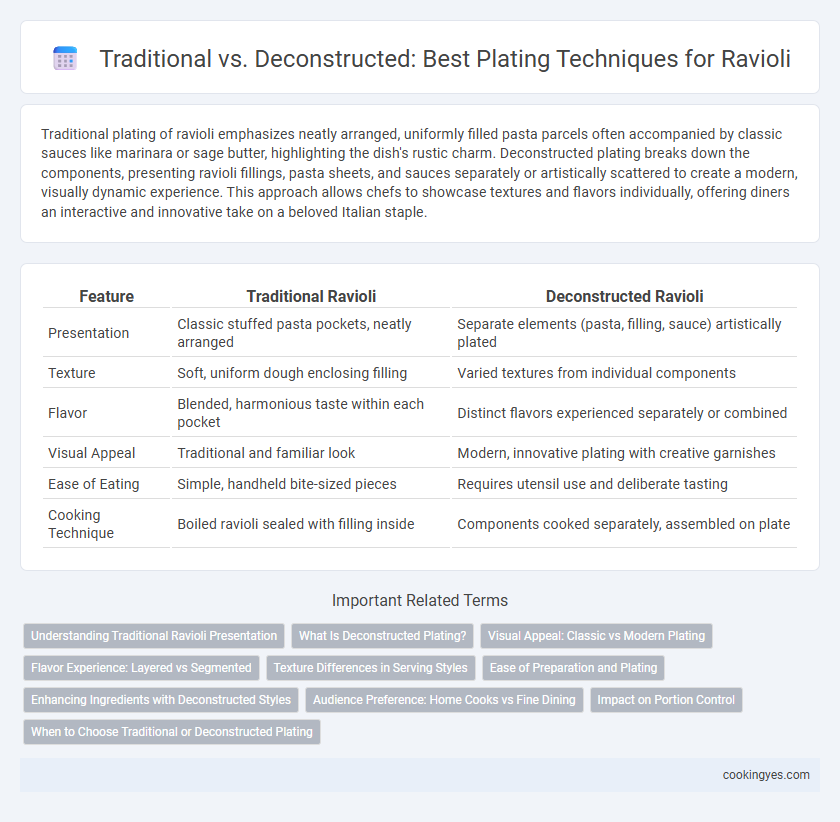Traditional plating of ravioli emphasizes neatly arranged, uniformly filled pasta parcels often accompanied by classic sauces like marinara or sage butter, highlighting the dish's rustic charm. Deconstructed plating breaks down the components, presenting ravioli fillings, pasta sheets, and sauces separately or artistically scattered to create a modern, visually dynamic experience. This approach allows chefs to showcase textures and flavors individually, offering diners an interactive and innovative take on a beloved Italian staple.
Table of Comparison
| Feature | Traditional Ravioli | Deconstructed Ravioli |
|---|---|---|
| Presentation | Classic stuffed pasta pockets, neatly arranged | Separate elements (pasta, filling, sauce) artistically plated |
| Texture | Soft, uniform dough enclosing filling | Varied textures from individual components |
| Flavor | Blended, harmonious taste within each pocket | Distinct flavors experienced separately or combined |
| Visual Appeal | Traditional and familiar look | Modern, innovative plating with creative garnishes |
| Ease of Eating | Simple, handheld bite-sized pieces | Requires utensil use and deliberate tasting |
| Cooking Technique | Boiled ravioli sealed with filling inside | Components cooked separately, assembled on plate |
Understanding Traditional Ravioli Presentation
Traditional ravioli presentation highlights perfectly uniform pillow-shaped pasta, neatly arranged to emphasize symmetry and elegance on the plate. Each ravioli is typically filled with classic ingredients like ricotta and spinach or meat, encased in a thin, tender dough that cooks evenly to maintain its shape. The dish is often finished with a simple sauce, such as sage butter or marinara, allowing the handcrafted pasta and its filling to remain the focal point.
What Is Deconstructed Plating?
Deconstructed plating of ravioli involves presenting the pasta's components separately rather than assembling them into traditional pockets, allowing each element like the filling, sauce, and pasta to be individually showcased. This method emphasizes texture contrast and visual appeal while offering diners a more interactive tasting experience. Traditional ravioli plating, by contrast, highlights the harmonious integration of ingredients within each sealed pasta piece, emphasizing classic combinations and familiar presentation.
Visual Appeal: Classic vs Modern Plating
Traditional ravioli plating emphasizes uniformity and symmetry, showcasing the pasta's intricate folds and sealing patterns, often accompanied by a simple sauce that highlights the dish's handcrafted nature. In contrast, deconstructed plating offers a modern visual appeal by artistically arranging ravioli components separately, creating a dynamic presentation that engages diners with varied textures and colors on the plate. This approach enhances the dining experience by transforming ravioli into a visually stimulating culinary art form while maintaining the essence of its flavors.
Flavor Experience: Layered vs Segmented
Traditional ravioli offers a layered flavor experience where pasta, filling, and sauce meld seamlessly, creating a harmonious bite with each forkful. Deconstructed ravioli presents a segmented flavor profile, allowing diners to savor the individual components distinctly, highlighting textures and nuanced tastes separately. This method emphasizes the contrast and complexity of each element, enhancing overall sensory appreciation.
Texture Differences in Serving Styles
Traditional ravioli plating preserves the pillow-like texture, showcasing tender pasta enveloping a creamy or meat-based filling. Deconstructed ravioli separates each component, emphasizing contrasting textures such as crisped pasta sheets, velvety fillings, and crunchy garnishes for a more dynamic sensory experience. This method highlights individual ingredient qualities, creating a varied mouthfeel compared to the uniform softness of traditional plating.
Ease of Preparation and Plating
Traditional ravioli involves stuffing and sealing pasta sheets, requiring careful handcrafting that can be time-consuming but ensures consistent flavors and textures. Deconstructed ravioli simplifies preparation by serving the filling, pasta, and sauce separately, allowing faster plating and creative presentation. Chefs favor deconstructed plating to reduce assembly time while offering a modern visual appeal without compromising the essence of classic ravioli ingredients.
Enhancing Ingredients with Deconstructed Styles
Deconstructed ravioli plating enhances the natural flavors of premium ingredients like fresh ricotta, roasted heirloom tomatoes, and basil-infused olive oil by presenting them in distinct, visually appealing elements that highlight texture and color contrasts. Traditional ravioli offers a comforting, unified bite with the pasta envelope encasing the filling, but the deconstructed style allows chefs to elevate each component, emphasizing ingredient quality and freshness. This approach transforms ravioli into a sophisticated dish that balances culinary artistry with refined taste experiences.
Audience Preference: Home Cooks vs Fine Dining
Home cooks often prefer traditional ravioli plating, emphasizing familiar presentation with neatly filled pasta pockets and classic sauce pairings for comfort and ease of preparation. Fine dining audiences favor deconstructed ravioli plating that highlights individual components like delicate pasta dough, refined fillings, and artful sauce placements, enhancing visual appeal and gourmet experience. Audience preference influences plating style, balancing accessibility for home cooking against the innovation and sophistication expected in upscale restaurants.
Impact on Portion Control
Traditional ravioli plating features perfectly folded pasta pockets with uniform fillings, enabling precise portion control by standardizing sizes and serving quantities. Deconstructed ravioli presents components separately, offering flexibility in portion adjustments but requiring careful measurement to maintain consistency. This method may enhance visual appeal but poses challenges for exact portion management compared to the traditional arrangement.
When to Choose Traditional or Deconstructed Plating
Traditional plating of ravioli suits formal dining or when emphasizing classic presentation, highlighting the pasta's texture and rich filling within a symmetrical layout. Deconstructed plating is ideal for modern or experimental menus, encouraging diners to explore individual components and contrasting flavors in a visually artistic manner. Choose traditional plating to evoke comfort and authenticity, while opting for deconstructed plating to impress with creativity and emphasize ingredient individuality.
Traditional vs Deconstructed for plating ravioli Infographic

 cookingyes.com
cookingyes.com